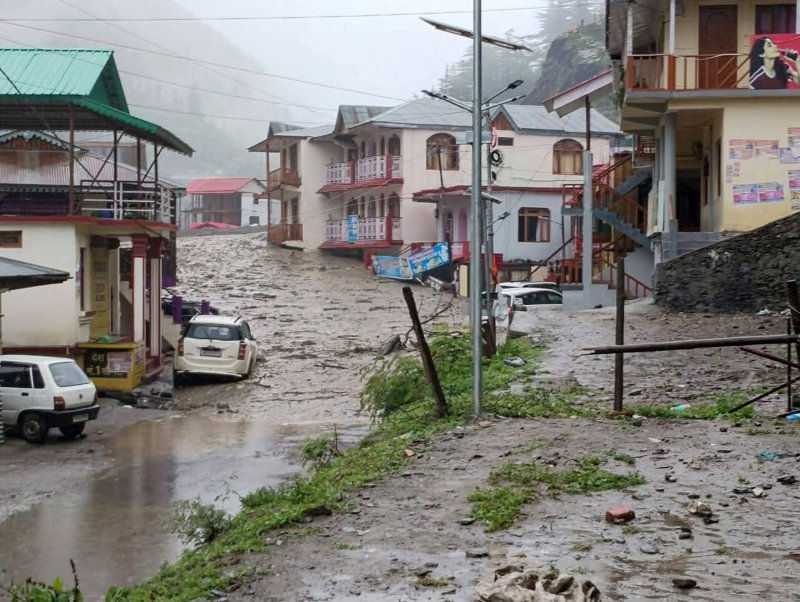Flash Flood Disaster in Uttarkashi, Uttarakhand: At Least 4 Dead, Dozens Missing
- J Venkateswara Rao
- Aug 6
- 3 min read

Breaking News: Cloudburst Triggers Flash Floods in Dharali, Uttarkashi
On the afternoon of 5 August 2025, a sudden and intense cloudburst over the Kheer Ganga catchment area sparked catastrophic flash floods and landslides in Dharali village, located within Uttarkashi district, Uttarakhand.
The torrent of debris-laden water and mud overwhelmed the settlement, destroying homes, shops, hotels, and even ancient landmarks including the Kalp Kedar Shiva temple.
Casualties & Missing Persons
Official figures confirm 4 deaths, with fears that the toll could rise as rescue teams continue to search under debris.
A staggering 50 to 100 people remain missing, including up to 9 army personnel stationed at a nearby camp in Harshil, now feared buried under landslide debris.
Rescue & Relief Operations
On-site teams include the Indian Army’s Ibex Brigade, the National Disaster Response Force (NDRF), State Disaster Response Force (SDRF), and the ITBP.
Even in adverse weather, over 130 people have been evacuated so far, with three Indian Air Force helicopters and Chinook choppers deployed for air rescue support.
Emergency medical care is being provided at army facilities in Harsil, and stranded residents are being moved to safer shelters.
Impact: Property, Heritage & Connectivity
Dozens of hotels and homestays—estimated 50+—were washed away or submerged, along with 40–50 homes in the village market area.
Roads were destroyed, cutting off access to Gangotri pilgrimage routes and blocking connections to Chamoli and India–China border areas.
The Kalp Kedar Shiva temple, an ancient and spiritual landmark, lies buried under rubble from the flash flood.
Underlying Causes: Climate & Geo Fragility
Experts highlight Uttarakhand’s rising vulnerability due to a combination of climate change effects, rapid unregulated tourism, and unstabilized hillside construction. The terrain’s sensitivity to flash floods and landslides is a recurring threat, especially during the monsoon season.
Government Response & Public Reactions
Chief Minister Pushkar Singh Dhami described the tragedy as “deeply saddening” and directed rescue teams to work on a war footing, coordinating food, medical aid, and shelter for stranded residents.
Union Home Minister Amit Shah reported the dispatch of multiple NDRF and ITBP teams to reinforce relief operations. Prime Minister Narendra Modi extended sympathies, promising full federal support and ensuring no stone is left unturned in rescue efforts.
Why This Matters: A Recurring Himalayan Alarm
The Uttarkashi cloudburst recreates a familiar tragedy reminiscent of earlier Himalayan disasters like the 2021 Chamoli flood and 2013 Uttarakhand floods—both exacerbated by accelerating climate volatility.
It underscores the urgent need for better disaster preparedness, sensible tourism planning, and protective regulation along fragile mountain slopes.
Quick Fact Sheet
Topic | Detail |
📍 Location | Dharali village, Uttarkashi district, Uttarakhand |
📅 Date & Cause | 5 Aug 2025, cloudburst triggering flash floods & landslides |
⚠️ Fatalities | At least 4 confirmed deaths, toll may rise |
🆘 Missing & Trapped | 50–100+ individuals, including army personnel |
🌊 Damage Scope | Dozens of hotels, homes, roads, Kalp Kedar temple lost |
👷 Rescue Teams | Army (Ibex), NDRF, SDRF, ITBP; IAF helicopter support |
🌧 Contributing Factors | Extreme monsoon rain, climate change, environmentally fragile terrain |
Voices from the Ground
Eyewitnesses likened the event to the horrific 2013 flood:
“It felt like the earth was letting out its roar... water came within seconds, wiping everything away,” recalled one shaken resident.Other locals described seeing entire buildings carried off in the torrent, and the helplessness of the villagers as they watched their homes disappear.
Final Take
This disaster is a stark reminder that the Himalayas are highly vulnerable to extreme monsoon events, intensified by climate change and unplanned development. While immediate rescue operations are in full swing, long-term mitigation strategies—such as sustainable tourism planning, enforcing construction norms, and improving early warning systems—are essential to prevent future catastrophes.



Comments